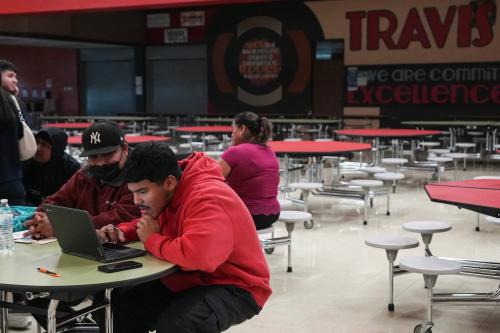Researchers have struggled for decades to identify a causal, or even correlational, relationship between time spent in school and improved learning outcomes for students. Some studies have focused on the length of a school year while others have focused on hours in a day and others on hours in the week.
In this blog post, we will look at time spent outside of school–specifically time spent doing homework–among different racial and socio-economic groups. We will use data from the American Time Use Survey (ATUS) to shed light on those differences and then attempt to explain those gaps, using ATUS data and other evidence.
What we know about out-of-school time
Measuring the relationship between out-of-school time and outcomes like test scores can be difficult. Researchers are primarily confounded by an inability to determine what compels students to choose homework during their time off over other activities. Are those who spend more time on homework just extra motivated? Or are they struggling students who need to work harder to keep up? What role do social expectations from parents or peers play?
Previous studies have examined the impact of this outside time use on educational outcomes for students. A 2007 study using data from Berea College in Kentucky identified a causal relationship between hours spent studying and a student’s academic performance through an interesting measure. The researchers took advantage of randomly assigned college roommates, paying attention to those who came to campus with a video game console in tow. They hypothesized students randomly assigned to a roommate without a video game console would study more, since all other factors remained equal. That hypothesis held up, and that group also received significantly higher grades, demonstrating the causal relationship.
Other research has relied on data collected through the American Time Use Survey, a study of how Americans spend their time, and shown the existence of a gender gap and a parental education gap in homework time. Other studies have looked at the relationship between holding a job and student’s time use in discretionary activities, like sleep, media consumption, and time spent on homework. We are curious about out-of-school differences in homework time by race and income.
Descriptive statistics of time use
We began with a general sample of 2,575 full-time high school students between the ages of 15 and 18 from the ATUS, restricting the sample to their answers about time spent on homework during weekdays and school months (September to May). Among all high school students surveyed (those that reported completing their homework and those that did not), the time allocated to complete homework amounted to less than an hour per day, despite the fact that high school teachers report they assign an average of 3.5 hours of homework per day.
To explore racial or income-based differences, in Figure 1, we plot the minutes that students reporting spending on homework separately by their racial/ethnic group and family income. We observed a time gap between racial groups, with Asian students spending the most time on homework (nearly two hours a day). Similarly, we observe a time gap by the students’ family income.

We can also use ATUS data to isolate when students do homework by race and by income. In Figure 2, we plot the percentage of high school students in each racial and income group doing homework by the time of day. Percentages remain low during the school day and then expectedly increase when students get home, with more Asian students doing more homework and working later into the night than other racial groups. Low-income students reported doing less homework per hour than their non-low-income peers.
Initial attempts to explain the homework gap
We hypothesized that these racial and income-based time gaps could potentially be explained by other factors, like work, time spent caring for others, and parental education. We tested these hypotheses by separating groups based on particular characteristics and comparing the average number of minutes per day spent on homework amongst the comparison groups.
Students who work predictably reported spending less time on educational activities, so if working disproportionately affected particular racial or income groups, then work could help explain the time gap. Students who worked allocated on average 20 minutes less for homework than their counterparts who did not work. Though low-income students worked more hours than their peers, they largely maintained a similar level of homework time by reducing their leisure or extracurricular activities. Therefore, the time gap on homework changed only slightly with the inclusion of work as a factor.
We also incorporated time spent taking care of others in the household. Though a greater percentage of low-income students take care of other household members, we found that this does not have a statistically significant effect on homework because students reduce leisure, rather than homework, in an attempt to help their families. Therefore, this variable again does not explain the time gaps.
Finally, we considered parental education, since parents with more education have been shown to encourage their children to value school more and have the resources to ensure homework is completed more easily. Our analysis showed students with at least one parent with any post-secondary degree (associate or above) reported spending more time on homework than their counterparts whose parents do not hold a degree; however, gaps by race still existed, even holding parental education constant. Turning to income levels, we found that parental education is more correlated with homework time among low-income students, reducing the time gap between income groups to only eight minutes.
Societal explanations
Our analysis of ATUS could not fully explain this gap in time spent on homework, especially among racial groups. Instead, we believe that viewing homework as an outcome of the culture of the school and the expectations of teachers, rather than an outcome of a student’s effort, may provide some reasons for its persistence.
Many studies, including recent research, have shown that teachers perceive students of color as academically inferior to their white peers. A 2016 study by Seth Gershenson et al. showed that this expectations gap can also depend on the race of the teacher. In a country where minority students make up nearly half of all public school students, yet minority teachers comprise just 18 percent of the teacher workforce, these differences in expectations matter.
Students of color are also less likely to attend high schools that offer advanced courses (including Advanced Placement courses) that would likely assign more homework, and thus access to rigorous courses may partially explain the gaps as well.
Research shows a similar, if less well-documented, gap by income, with teachers reporting lower expectations and dimmer futures for their low-income students. Low-income students and students of color may be assigned less homework based on lower expectations for their success, thus preventing them from learning as much and creating a self-fulfilling prophecy.
In conclusion, these analyses of time use revealed a substantial gap in homework by race and by income group that could not be entirely explained by work, taking care of others, or parental education. Additionally, differences in educational achievement, especially as measured on standardized tests, have been well-documented by race and by income. These gaps deserve our attention, but we should be wary of blaming disadvantaged groups. Time use is an outcome reflecting multiple factors, not simply motivation, and a greater understanding of that should help raise expectations–and therefore, educational achievement–all around.
Sarah Novicoff contributed to this post.









Commentary
Analyzing ‘the homework gap’ among high school students
August 10, 2017